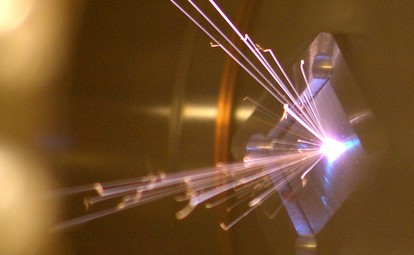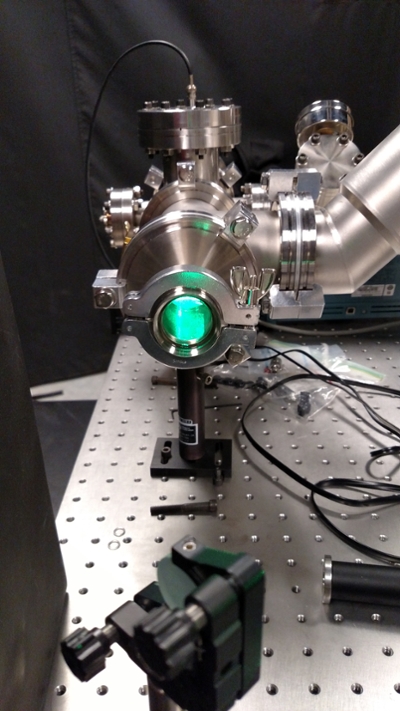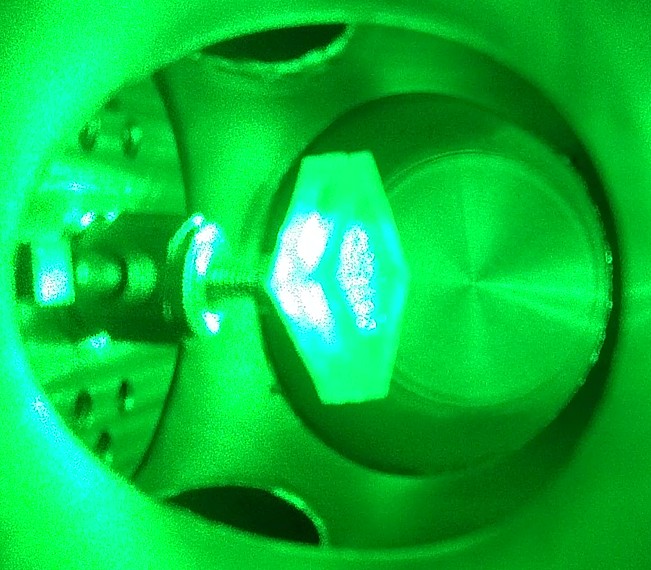Research - Aerospace optics
Project #1: Laser Space Debris Removal
Concept and Motivation
This research project, managed by Dr. John Sinko and started at SCSU around 2017, seeks development of laser ablation-based strategies for removing orbital debris from the space environment. Human use of space since 1957 has produced a glut of trash in near-Earth orbital space including such objects as rocket engines and casings, defunct satellites, and shrapnel from past collisions of satellites. The "Kessler Syndrome," an out-of-control cascade in which the number of debris particles grows by collisions, could limit practical use of Earth orbital space for decades.

Due to the prevalence of aluminum, titanium and steel in the current debris cloud, our project team has focused on removal of these particular metal materials using either laser vaporization (turning the material to less hazardous gas), or propulsive deorbit (pushing material into the Earth atmosphere where it burns up). Our lab uses a spherical, 18" diameter scientific vacuum chamber to simulate space pressures. Thrust is measured using force sensors and an impulse pendulum. Removed mass is measured either directly using a balance, or inferred using crater imaging with an optical profilometer. Heat accumulation in the samples is measured with a wire thermistor. High speed videography analysis helps resolve the energy and momentum imparted to ejecta from the ablation event. SCSU Physics majors Chase Negen, Naqsh E Zafar, and Veronica Sevilla Rubi were crucial in pushing this research forward due to their diligence in the laboratory. SCSU Physics major Amrit Chhetri is now studying ejected particles. An SCSU Mechanical Engineering Senior Design team (Justin Hauswirth, Shawn Kamphuis, and Joel Vincent under leadership of Dr. Serdar Sezen) was also instrumental in building a low-outgas linear translation stage for vacuum positioning of lens and target for improving data collection speed without frequent vent-pump cycles to adjust the target and focusing lens.
Awards:
- 4/23/2021: Naqsh E Zafar and Veronica Sevilla Rubi, 10th Annual Minnesota State Conference of Undergraduate Scholarly and Creative Activity, “Laboratory Study of Energy Distribution During Laser Removal Process of Aluminum Space Debris,” Best in Session Award, in Oral Session 3: Applications of Science
- 4/20/2021: Amrit Chhetri, SCSU Huskies Showcase, "Analysis of Particle Ejecta in Laser Ablation Of Aluminum," Our Husky Compact Dimension of the Year Reflection Finalist
- 4/2020: Naqsh E Zafar, SCSU Huskies Showcase, "Energy Distribution Diagram for Laser Vaporization of Aluminum Space Debris," Our Husky Compact Dimension of the Year Reflection Finalist
Recent Funding:
- 4/2020-6/2021: SCSU Long-Term Faculty Improvement Grant (Dr. John Sinko), $9931.49, "Experimental Study on Space Debris Removal by Laser Vaporization"
- 5/2018-6/2020: SCSU Early Career Award (Dr. John Sinko), $8000, "Removal of Aluminum Space Debris by Laser Vaporization"
Related Publications:
- 2019, J. E. Sinko and C. D. Negen, "Experimental Study on Microsecond Laser Ablation of Simulated Space Debris Targets," in online proceedings of AIAA Aviation 2019 Forum, 17-19 June 2019, Dallas, TX, Paper No. AIAA-2019-3565. DOI: https://doi.org/10.2514/6.2019-3565
Project #2: Cooperative Laser Ablative Tractor Beams
Concept and Motivation
This research project, begun in Nagoya, Japan in 2008 by Dr. John Sinko in conjunction with the 501c(3) Institute for Materials, Energetics and Complexity, seeks development of cooperative laser tractor beams to rescue astronauts on orbit or deorbit space debris. A cooperative laser tractor beam doesn't work quite like the movies. It will require a special receiver and propellant on board the target, which is activated by the laser to create thrust.
Our present focus is to develop targets and propellants. Previous work at Nagoya University and the University of Alabama Huntsville tested bilayer propellant performance. So far at SCSU, we have explored a different strategy more similar to the HX thruster of Jordin Kare. We applied argon and Nd:YAG lasers to produce thrust, measured at simulated space pressures in a vacuum chamber using piezoelectric force sensors and impulse pendulums. At SCSU, undergraduate physics major Tyler Baxter was instrumental in carrying this project forward, including design and eventual 3D print of a prototype test chamber, and lab tests under vacuum using solid carbonate propellants for forced evolution of propellant gases. Tyler made an award-winning oral presentation at the 2018 Minnesota State Conference of Undergraduate Scholarly and Creative Activity, and presented one of two presentations at the 53rd AIAA Joint Propulsion Conference in Atlanta, GA in July 2017.
Awards:
- 3/2018: Minnesota State Conference of Undergraduate Scholarly and Creative Activity, 1st Place Oral Presentation by Tyler Baxter
- 4/19/2016: SCSU Student Research Colloquium, 1st Place, Poster Competition (Tyler Baxter, with Dr. John Sinko, Dr. Clifford Schlecht, and Mark Gill)
Recent Funding:
- 12/2015-6/2017: SCSU University Researcher Award (Dr. John Sinko), $5000, "Propellant Development for Astronaut Retrieval by Laser Tractor Beam"
- 12/2016-6/2017: SCSU New Researcher Award (Dr. John Sinko), $4000, "Target Chamber Optimization for Laser Tractor Beam Astronaut Retrieval"
Related Publications:
- 8/2017: J. E. Sinko, T. R. Baxter, M. Gill, and C. Adam Schlecht, "Thrust Assessment for a Laser Tractor Beam," 53rd AIAA/SAE/ASEE Joint Propulsion Conference, AIAA Propulsion and Energy Forum, 10-12 July 2017, Atlanta, GA, USA, AIAA 2017-4960 (2017). DOI: https://doi.org/10.2514/6.2017-4960
- 8/2017: T. R. Baxter and J. E. Sinko, "Laser-Induced Carbon-Doped Carbonate Propellant Thermal Decomposition for Use in Beamed Energy Propulsion," 53rd AIAA/SAE/ASEE Joint Propulsion Conference, AIAA Propulsion and Energy Forum, 10-12 July 2017, Atlanta, GA, USA, AIAA 2017-4958 (2017). DOI: https://doi.org/10.2514/6.2017-4958
- 2010: J. E. Sinko and C. A. Schlecht, "CO2 Laser Ablation Propulsion Tractor Beams," in AIP Conference Proceedings 1230, 282, 2010. DOI: https://doi.org/10.1063/1.3435444
- 5/2012: J. E. Sinko, "Laser Ablation Propulsion Tractor Beam System," Journal of Propulsion and Power 26(1), pp. 189-191, 2010 (published online 2012). DOI: https://doi.org/10.2514/1.46037
Capabilities
Instrumentation
Lasers and Light Sources
- Argon-Ion laser (450-515nm)
- HeNe lasers (633,3390nm)
- pulsed Nd:YAG laser (1064nm, 532nm, 355nm)
- diode laser (450nm, 532nm, 780nm, 980nm)
- calibrated Thorlabs halogen lamp
Optical Analysis
- Newport and Thorlabs Photodiode Detectors
- Portable Ocean Optics Flame Extended Range (UV-Vis-NIR) spectrometer
- Thorlabs Broad Spectrum Thermal Sensor
- Thorlabs 2" Integrating Sphere
- Gentec EO pulsed laser energy detector
- Czerny-Turner Monochromator
- In-house Interferometric Sensing
- Optical microscopy
- Optical profilometry
Scientific Imaging
- Point Grey Flea3 cameras
- High speed video (nac Image Technologies, HX-7S, up to 150000 fps)
- SEM

